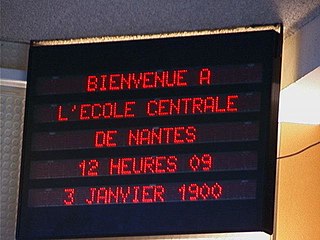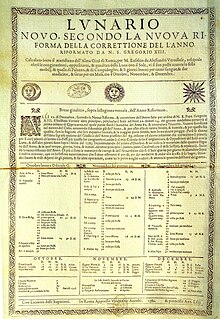
The traditional China calendar, or Former Calendar, Traditional Calendar or Lunar Calendar, is a lunisolar calendar which reckons years, months and days according to astronomical phenomena. It is defined by GB/T 33661-2017, "Calculation and promulgation of the Chinese calendar", issued by the Standardisation Administration of China on 12 May 2017.
A calendar date is a reference to a particular day represented within a calendar system. The calendar date allows the specific day to be identified. The number of days between two dates may be calculated. For example, "24 January 2020" is ten days after "14 January 2020" in the Gregorian calendar. The date of a particular event depends on the observed time zone. For example, the air attack on Pearl Harbor that began at 7:48 a.m. Hawaiian time on 7 December 1941 took place at 3:18 a.m. Japan Standard Time, 8 December in Japan.
An epoch, for the purposes of chronology and periodization, is an instant in time chosen as the origin of a particular calendar era. The "epoch" serves as a reference point from which time is measured.

Japanese calendar types have included a range of official and unofficial systems. At present, Japan uses the Gregorian calendar together with year designations stating the year of the reign of the current Emperor.
The year 10,000 problem is the class of all potential time formatting and storage bugs that would emerge when the need to express years with five digits arises. The problem can have discernible effects today, but is also sometimes mentioned for humorous effect as in RFC 2550.

The New Taiwan dollar is the official currency used in Taiwan. Formally, one dollar (圓) is divided into ten dimes (角), and to 100 cents (分), although cents are never used in practice. The New Taiwan dollars has been the currency of Taiwan since 1949, when it replaced the Old Taiwan dollar, at a rate of 40,000 old dollars per one new dollar. There are a variety of alternative names to the units in Taiwan. The unit of dollar is typically informally written with the simpler equivalent character as 元, except when writing it for legal transactions such as at the bank, when it has to be written as 圓. Colloquially, the currency unit is called 塊 in Mandarin, 箍 in Taiwanese Hokkien, and 銀 in Hakka.
The sexagenary cycle, also known as the Stems-and-Branches or ganzhi, is a cycle of sixty terms, each corresponding to one year, thus a total of sixty years for one cycle, used for reckoning time in China and the rest of the East Asian cultural sphere. It appears as a means of recording days in the first Chinese written texts, the Shang oracle bones of the late second millennium BC. Its use to record years began around the middle of the 3rd century BC. The cycle and its variations have been an important part of the traditional calendrical systems in Chinese-influenced Asian states and territories, particularly those of Japan, Korea, and Vietnam, with the old Chinese system still in use in Taiwan.

The Doomsday rule is an algorithm of determination of the day of the week for a given date. It provides a perpetual calendar because the Gregorian calendar moves in cycles of 400 years.

East Asian age reckoning originated in China and continues in limited use there along with Tibet and Japan, but is still common in Korea. People are born at the age of one, i.e. the first year of lifetime using an ordinal number, and on Chinese New Year or New Year's Day one year is added to their age. Since age is incremented at the beginning of the lunar or solar year, rather than on the anniversary of a birthday, people may be one or two years older in Asian reckoning than in the international age system.
A regnal year is a year of the reign of a sovereign, from the Latin regnum meaning kingdom, rule. Regnal years considered the date as an ordinal, not a cardinal number. For example, a monarch could have a first year of rule, a second year of rule, a third year of rule, and so on, but not a zeroth year of rule.

The Republic of China calendar is the official calendar of the Republic of China. It is used to number the years for official purposes only in the Taiwan area since 1949. It was used in the Chinese mainland from 1912 until the establishment of the People's Republic of China in 1949.

The civil calendar is the calendar, or possibly one of several calendars, used within a country for civil, official, or administrative purposes. The civil calendar is almost always used for general purposes by people and private organizations.
In computer science, time formatting and storage bugs are a class of software bugs which may cause time and date calculation or display to be improperly handled. These are most commonly manifestations of arithmetic overflow, but can also be the result of other issues. The most well-known consequence of bugs of this type is the Y2K problem, but many other milestone dates or times exist that have caused or will cause problems depending on various programming deficiencies.

Dual dating is the practice, in historical materials, to indicate some dates with what appears to be duplicate, or excessive digits, sometimes separated by a hyphen or a slash. This is also often referred to as double dating. The need for double dating arose from the transition from an older calendar to a newer one. For example, in "10/21 February 1750/51", the dual day of the month is due to the correction for excess leap years in the Julian calendar by the Gregorian calendar, and the dual year is due to some countries beginning their numbered year on 1 January while others were still using another date.

The Democratic People's Republic of Korea calendar, DPRK calendar, or Juche calendar, named after the Juche ideology, is the system of year-numbering used in the Democratic People's Republic of Korea.
Chinese era names were titles used by various Chinese dynasties and regimes in Imperial China for the purpose of year identification and numbering. The first monarch to adopt era names was the Emperor Wu of Han in 140 BCE, and this system remained the official method of year identification and numbering until the establishment of the Republic of China in 1912 CE. Other polities in the Sinosphere—Korea, Vietnam and Japan—also adopted the concept of era name as a result of Chinese cultural influence.

The Year 2000 problem, also known as the Y2K problem, the Millennium bug, Y2K bug, the Y2K glitch, or Y2K, refers to events related to the formatting and storage of calendar data for dates beginning in the year 2000. Problems were anticipated, and arose, because many programs represented four-digit years with only the final two digits – making the year 2000 indistinguishable from 1900. The assumption of a twentieth-century date in such programs could cause various errors, such as the incorrect display of dates and the inaccurate ordering of automated dated records or real-time events.
The Republic of China is a state in East Asia, commonly known as Taiwan.

The adoption of the Gregorian Calendar was an event in the modern history of most nations and societies, marking a change from their traditional dating system to the modern dating system that is widely used around the world today. Some countries adopted the new calendar from 1582, some did not do so before the early twentieth century, and others did so at various dates between; however a number continue to use a different civil calendar. For many the new style calendar is only used for civil purposes and the old style calendar remains used in religious contexts. Today, the Gregorian calendar is the world's most widely used civil calendar. During – and for some time after – the change between systems, it has been common to use the terms Old Style and New Style when giving dates, to indicate which calendar was used to reckon them.











